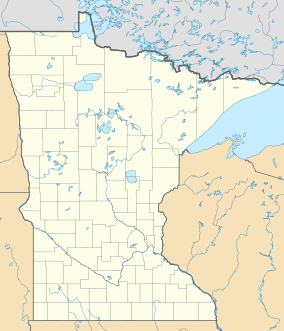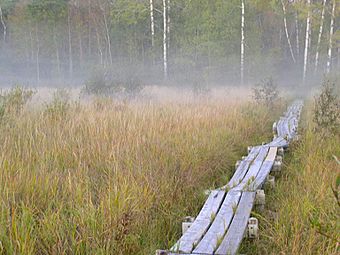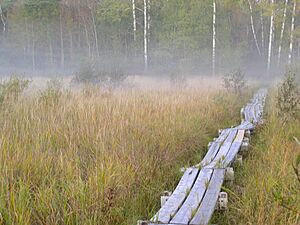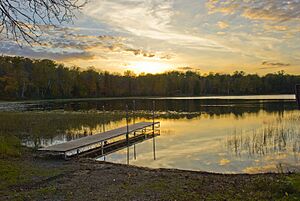Savanna Portage State Park facts for kids
Savanna Portage State Park is a special state park in Minnesota, USA. It was created in 1961 to protect the historic Savanna Portage. This portage was a tough, 6-mile (9.7 km) long trail. It connected two big river systems: the Mississippi River and Lake Superior.
The portage trail crosses a natural dividing line called a drainage divide. On one side, the West Savanna River flows towards the Mississippi River and then to the Gulf of Mexico. On the other side, the East Savanna River flows in the opposite direction. It goes to the Saint Louis River, then to Lake Superior, the Great Lakes, and finally the Saint Lawrence River to the Atlantic Ocean.
The Savanna Portage was used for hundreds of years by Native Americans. Later, European explorers, fur traders, and missionaries also used it. It was a super important path connecting the Mississippi waterways in the west with the Great Lakes in the east. The portage was added to the National Register of Historic Places in 1973 because of its importance in trade, exploration, and travel. The park is about 17 miles (27 km) northeast of McGregor, Minnesota and 50 miles (80 km) west of Duluth.
Contents
Park's Landscape and History
Savanna Portage State Park sits on a special natural boundary. This boundary separates the lands where water flows towards the Great Lakes from those where water flows towards the Gulf of Mexico. Both eventually reach the Atlantic Ocean.
How the Land Was Formed
The park area is a flat plain that used to be the bottom of a huge glacial lake. During the last Wisconsinan glaciation (a time when glaciers covered much of North America), a giant glacier melted. It left behind connected lakes called Glacial Lake Aitkin and Glacial Lake Upham. As the glacier melted and the lakes slowly drained, they left behind sand and dirt. This created the flat land we see today.
Over time, a smaller river, the Saint Louis River, "captured" the water flow of a larger river, the Cloquet River. This left the East Savanna River flowing towards Lake Superior and the West Savanna River flowing towards the Mississippi River. This natural split created the perfect spot for the portage trail.
The Famous Savanna Portage Trail
The flat, wet land in this old lakebed made a difficult but important path. It allowed people to travel overland between the East and West Savanna Rivers. Wolf Lake, where the East Savanna River starts, is only about 800 yards (730 m) east of Savanna Lake on the West Savanna.
The portage trail is about 6 miles (9.7 km) long. It begins in a swampy area and then goes west through a wooded, higher area to reach the West Savanna River.
Native Americans used this trail for a very long time. Later, it became a main route for explorers, missionaries, and fur traders traveling between the Great Lakes and the Mississippi Valley. Travelers from the east would leave Lake Superior near Fond du Lac (where Duluth is now). They would then paddle up the tough, rocky Saint Louis River.
After that, they would turn southwest up the slow-moving East Savanna River. When they reached a small hill, they started the portage. The eastern part of the portage was very swampy and full of mosquitoes. It was known as one of the hardest parts of any journey for the voyageurs (fur traders). People often had to walk waist-deep through the "boundless swamp." Eventually, they reached a forest, and the trail led to the West Savanna River. This river flows into Big Sandy Lake and then the Upper Mississippi River. If the water was low, the rivers became too shallow for canoes. Then, travelers would have to walk even further overland to Big Sandy Lake.
Who Used the Portage?
Europeans likely started using the portage as early as 1679. That's when Daniel Greysolon, Sieur du Lhut visited a Sioux village at Big Sandy Lake. Many fur traders also used the portage. Some only went as far as the American Fur Company's big trading post on Big Sandy Lake. This post was run by William Aitkin in the 1820s and 1830s, when the trail was used the most.
Many famous explorers and scientists also crossed the portage:
- David Thompson, a British explorer, in 1798.
- Zebulon Pike, an early American explorer, in 1805.
- Lewis Cass, an American general, in 1820.
- Henry Schoolcraft, a geologist, in 1820 and 1832.
- Joseph Nicollet, a French mapmaker, in 1836.
- Laurence Oliphant, a British writer, in 1854.
Even tourists, like Count Ferdinand von Zeppelin (who invented the airship!), crossed in 1863.
When the Northern Pacific Railroad reached nearby McGregor in 1870, the portage was no longer used for long-distance travel. However, local people still used it for trade and to reach the inner areas. The trail's path was found and marked in 1926. More detailed marking happened from the 1940s to the 1960s, and again in 1981 using special archaeological methods. Today, most of the old route is a hiking trail.
Savanna Portage State Park Today
The interest in the old portage trail led to the creation of Savanna Portage State Park in 1961. At about 14,000 acres (57 km2), it became the third-largest park in Minnesota. The park includes the Floodwood Game Refuge and is almost surrounded by the Savanna State Forest. The park is about 13.5 miles (21.7 km) long and no more than 4 miles (6.4 km) wide. Its shape is partly because it follows the path of the portage.
Today, the park has 15,818 acres (64 km2) of hills, lakes, and bogs. There are many fun things to do here:
- Camping in summer and winter.
- Hiking, snowshoeing, and cross-country skiing on the old portage and other trails.
- Mountain biking and snowmobiling.
- Swimming, fishing, canoeing, and boating on Loon Lake.
Plants and Animals
The park is named "Savanna" because of its open, marshy grasslands. The wet areas, called peat bogs and marshes, have plants like sedges, black spruce, tamarack, and white cedar trees. The higher, drier areas have a mix of hardwood and conifer trees. These include maple, oak, poplar, birch, white pine, and red pine.
Animals You Might See
Many different animals live in the park:
- Large animals like moose, black bears, deer, and timber wolves.
- Smaller animals like coyotes and skunks.
- Amphibians and wood turtles.
Many types of birds also call the park home:
- Majestic bald eagles.
- Ground birds like sharp-tailed grouse.
- Small, colorful warblers.
- Boreal owls, which come from Canada to spend the winter here.
- Tall sandhill cranes.
- Beautiful trumpeter swans.
- And the iconic loons, known for their calls.







